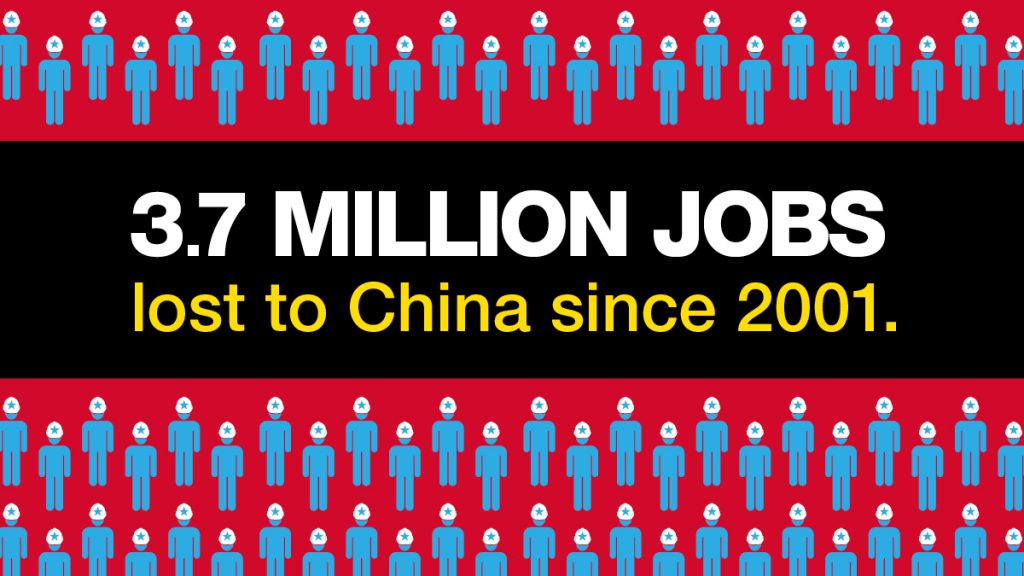
First two years of Trump presidency saw 700,000 jobs lost.
America’s trade deficit with China continues to grow and plague manufacturing in the United States.
Workers saw 3.7 million U.S. jobs lost to China since 2001, with more than 700,000 lost in the first two years of Donald Trump’s presidency, according to a study released Thursday by the Economic Policy Institute (EPI).
From 2001 to 2018, every state and every congressional district has suffered job loss due to the U.S.-China trade deficit, though five states in particular have been crushed, based on total jobs lost: California (654,200 jobs lost), Texas (334,700), New York (185,200), Illinois (162,300) and Florida (150,500).
If you examine job loss as a share of total state employment, New Hampshire, Oregon, California, North Carolina, Minnesota, Massachusetts, Wisconsin, Vermont, Indiana and Idaho have been the most severely impacted.
Notably, states that have been hardest hit by the trade deficit with China are among key battleground states for the 2020 presidential election.
Three-fourths of the jobs lost since 2001 were in the manufacturing industry. However, even high-end technology products, such as computers, airplanes and biotechnology, which are often purported to be insulated from offshoring, were also shown to be steadily losing out to China, with a $134.6 billion trade deficit in advanced technology products in 2018.
Though the Trump administration has wrestled with China in trade talks for more than two years and has won some concessions from Beijing in “Phase 1” of the U.S.-China trade deal, there’s much that remains to be done to stem the tide of jobs leaving America’s shores.
Alliance for American Manufacturing President Scott Paul said in a press release:
“This problem didn't happen overnight, and it won't be fixed overnight either. President Trump was right to take on China’s trade cheating, but the Phase 1 trade deal isn't good enough. Manufacturing plants around the country continue to close and millions of American workers lost good-paying jobs that support families and the communities in which they live. The answer isn’t to go back to a policy of looking the other way when China cheats. Rather, it’s to be tough, but in a much smarter and more strategic manner.”
The trade deficit widens despite the Trump administration’s “Phase 1” agreement, which negotiated China’s commitment to an additional $200 billion purchase of American goods and services by 2021 but failed to address the critical structural changes needed to resolve China’s trade cheating — namely, industrial subsidies as well as labor and environmental standards. Furthermore, China continues to manipulate its currency to unfairly advantage its industries, making its goods artificially cheap despite tariffs.
On the campaign trail in 2015, Trump promised to declare China a currency manipulator on day one of his term in office. It took more three years, but the Treasury Department finally labeled China a currency manipulator in August 2019. Then, this January, the administration removed the designation ahead of the announcement of a “Phase 1” U.S.-China trade deal, further diminishing U.S. leverage in trade negotiations.
As we’ve seen time and time again, the assault American workers have endured has real consequences. Between 2001 and 2011, the U.S.-China trade deficit reduced the income of directly impacted workers by $37 billion per year. As workers are forced out of family-supporting factory jobs, corporations benefit from lower wages by offshoring, further exacerbating income disparity in America, a top concern for voters in the coming election according to the Pew Research Center.
In 2011, "trade with low-wage counties lowered annual wages by 5.5%–roughly $1,800 per worker for all full-time, full-year workers without a college degree. To provide comparable economywide impact estimates, assume that 100 million workers without a college degree suffered losses of $1,800 per year,” the report states.
Moreover, manufacturing workers displaced by the trade deficit with China have especially struggled to find alternate employment. In the report, EPI cites Bureau of Labor Statistics that show that “one-third (35.4%) of long-tenured (employed more than three years) manufacturing workers displaced from January 2015 to December 2017 were not working in January 2018, including 21.7% of long-tenured manufacturing workers displaced who were not in the labor force, i.e., no longer even looking for work, and 13.7% who were unemployed.”
American workers deserve a better deal. After decades of job loss eroding manufacturing communities around the country, millions of displaced workers are waiting for Trump to fulfill his promise to finally fight for them in trade negotiations with China.
Several Members of Congress responded to the report, grieving the destruction of America’s manufacturing communities and urgently calling for a strong response.
"In 2000, I voted against letting China into the World Trade Organization,” said Sen. Tammy Baldwin (D-Wis). “Since joining, China has refused to play by the international rules that all WTO members must agree to. As this report clearly shows, when China cheats, Wisconsin workers lose.”
Sen. Bernie Sanders (D-V.T.) indicted America’s current trade policies as burdening the nation’s working class for the sake of corporations. “As this report shows, Permanent Normal Trade Relations with China led to the loss of 3.7 million jobs. This is further evidence that our trade policies have been an unmitigated disaster for workers,” Sanders said. “We need to fundamentally rewrite our trade deals so they reflect the interests of working families, not the CEOs who helped write them.”
You can find additional comments from Members of Congress here, including statements from Rep. Debbie Dingell (D-Mich.), Rep. John Garamendi (D-Calif.), Rep. Marcy Kaptur (D-Ohio), Rep. Daniel Lipinski (D-Ill.), Rep. Mark Pocan (D-Wis.), Rep. Tim Ryan (D-Ohio) and Rep. Pete Visclosky (D-Ind.)
You can find EPI’s full report here.
